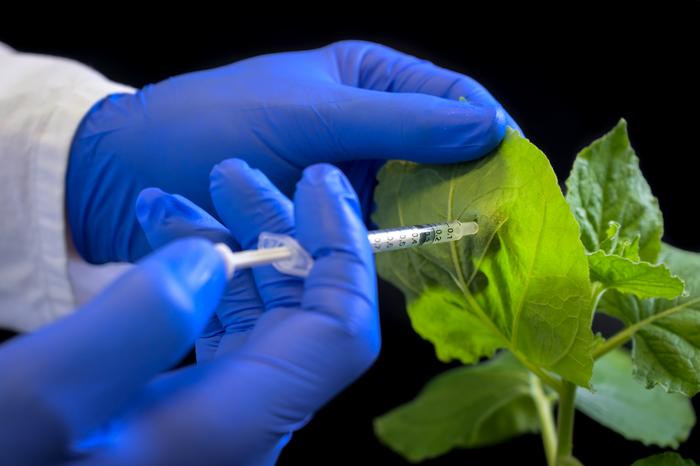
Researchers at Martin Luther University Halle-Wittenberg (MLU) have made significant strides in plant protection by developing new RNA-based active agents to combat the Cucumber mosaic virus (CMV), a prevalent threat to global agriculture. CMV is notorious for its rapid spread and devastating impact on over 1,200 plant species, including vital crops like cucumbers, squash, and cereals. For decades, farmers have struggled with the absence of effective treatments, but the groundbreaking work from MLU researchers may offer a formidable long-term solution.
The innovative approach involves harnessing the plant’s own immune system, utilizing RNA molecules to enhance their defenses against viral infections. Laboratory experiments demonstrated remarkable efficacy, with treated plants showing survival rates of 80 to 100 percent even when exposed to high viral loads. These promising findings, detailed in a recent article in Nucleic Acids Research, highlight a monumental shift in how plant viruses can be confronted and managed.
Cucumber mosaic virus is particularly insidious due to the variety of aphids that can transmit it. Once a plant is infected, it becomes symptomatic, typically exhibiting a mosaic pattern on its leaves, indicating that the virus is wreaking havoc on its physiology. The consequences are dire; infected plants struggle to thrive, and their fruits cannot be marketed. In light of this scenario, the new RNA-based agents developed by the MLU team represent a beacon of hope, paving the way toward sustainable agricultural practices and enhanced food security.
Upon infection, CMV exploits the cellular machinery of plants to replicate its genetic material—ribonucleic acid (RNA). The introduction of exogenous RNA molecules into the plant cells sets off an immune response, wherein unique enzyme ‘scissors’ detect and cleave the viral RNA, sparking a cascade of defensive measures across the plant’s tissue. This complex interplay yields small interfering RNAs (siRNAs), which play a crucial role in rallying the plant’s defenses against subsequent viral assaults.
While the natural antiviral response is generally suboptimal, MLU researchers have developed a methodology to identify highly efficient siRNA molecules, allowing for the optimization of the plant’s defense mechanisms. By combining these identified siRNAs into efficient double-stranded RNA molecules (edsRNAs), the researchers have formulated agents that act as a delivery system to enhance the plant’s immune responses against CMV.
The significance of edsRNAs lies in their ability to release a multitude of potent siRNA species targeting various vulnerabilities within the viral genome. In their experiments with the model plant Nicotiana benthamiana, MLU researchers observed stark contrasts in survival rates between treated and untreated plants, where untreated specimens succumbed to high viral exposure. The strategic design of the edsRNAs not only bolsters the immediate defensive capabilities but also addresses the rapid evolutionary adaptations of RNA viruses like CMV, offering multiple points of attack against potential mutations.
One of the remarkable advantages of edsRNA technology is its flexibility in responding to emerging viral strains. With the capability to expedite the selection and integration of new siRNAs, researchers can modify the active agents to counteract viral adaptations within a matter of weeks. This feature could prove invaluable in an agricultural landscape increasingly challenged by the emergence of resistant viral strains.
As the research progresses, initial applications have primarily been limited to laboratory settings, where substances have been introduced through injection or topical application. However, collaboration with specialists in pharmaceutical development aims to transition these RNA-based treatments into more practical formulations. Methods such as spray application are being explored to expedite field trials and ultimately bring these innovative protective agents to market for use in real-world agricultural practices.
Field trials will be critical in assessing the performance of these RNA-based agents under varied environmental conditions, ensuring that they provide reliable protection against CMV and potentially other agricultural pathogens. However, the pathway from laboratory success to commercialization is fraught with regulatory hurdles, requiring extensive evaluation and approval processes before these agents can be made widely available to farmers.
Looking ahead, the researchers are in discussions with industry partners regarding the production and commercialization of these novel RNA-based crop protection products. The recent approval of the first RNA-based pesticide in the United States serves as a reassuring precedent, suggesting that regulatory challenges can be navigated successfully, paving the way for future innovations in plant protection strategies.
As the agricultural sector braces for the ever-evolving threats of viral pathogens, the RNA technologies pioneered by MLU researchers not only hold promise for advancing crop health but also contribute broadly to sustainable farming practices. With a growing understanding of viral genomics and host responses, we enter a new era of plant protection that could redefine our relationship with agriculture.
In summary, the promising advancements made by MLU in developing RNA-based agents against Cucumber mosaic virus signal a transformative leap in agricultural science. As researchers refine these strategies and work toward practical applications, the agricultural community stands on the brink of a sustainable solution to a long-standing challenge, with the potential to enhance food security and resilience in the face of evolving environmental pressures.
Subject of Research: RNA-based plant protection against Cucumber mosaic virus
Article Title: A new level of RNA-based plant protection – dsRNAs designed from functionally characterized siRNAs highly effective against Cucumber Mosaic Virus
News Publication Date: 19-Mar-2025
Web References: 10.1093/nar/gkaf136
References: Information sourced from Nucleic Acids Research journal article.
Image Credits: Credit: Uni Halle / Heiko Rebsch
Keywords: RNA-based agents, Cucumber mosaic virus, plant protection, siRNA, agricultural innovation, plant immune system, crop security, viral pathogens, sustainable agriculture.
Tags: combating agricultural plant diseasesCucumber mosaic virus solutionseffective treatments for CMVenhancing plant immune systemsglobal agriculture threatsinnovative crop protection methodsMartin Luther University Halle-Wittenberg researchplant disease managementplant virus researchRNA-based plant protection strategiessustainable farming practicesviral infections in plants





